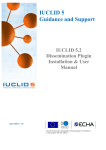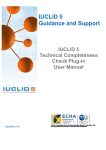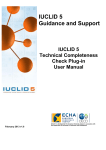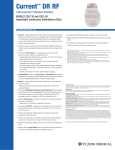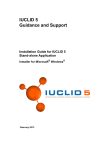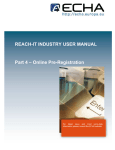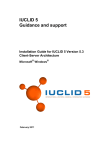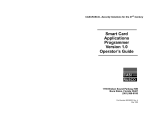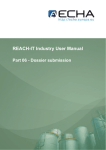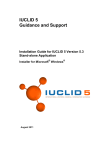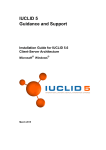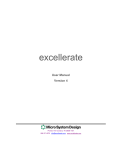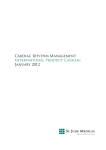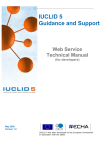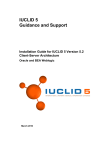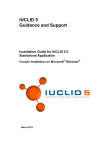Download IUCLID 5 Plugin
Transcript
IUCLID 5 Guidance and Support IUCLID 5 Technical Completeness Check Plugin User Manual December 2010 v1.1 IUCLID 5 has been developed by the European Commission in association with the OECD IUCLID 5: Technical Completeness Check plugin – User Manual Table of contents Principle of the Technical Completeness Check (TCC) plugin........................................................ 3 Adding the plugin to your local IUCLID 5 installation ....................................................................... 3 2.1 Workstation / stand-alone installation ........................................................................................ 4 2.2 Distributed installation ................................................................................................................ 5 3 Starting the TCC Tool ...................................................................................................................... 6 4 Using the TCC tool ........................................................................................................................... 7 4.1 STEP 1: select the dossier/substance ....................................................................................... 7 4.1.1 Checking dossiers ............................................................................................................. 8 4.1.2 Checking substances ........................................................................................................ 8 4.2 STEP 2: select the template (optional)..................................................................................... 10 4.2.1 Combined dossier............................................................................................................ 10 4.2.2 Lead of a joint submission ............................................................................................... 11 4.2.3 Member of a joint submission.......................................................................................... 12 4.3 STEP 3: TCC results and interpretation................................................................................... 13 4.3.1 TCC result toolbar............................................................................................................ 14 4.3.2 Filtering the result table ................................................................................................... 14 4.3.3 TCC result table............................................................................................................... 15 4.3.4 TCC version information .................................................................................................. 17 1 2 Table of figures Figure 1: TCC tool run button .................................................................................................................................. 6 Figure 2: TCC tool via menu item ............................................................................................................................ 6 Figure 3: TCC Toggle button ................................................................................................................................... 6 Figure 4: Run TCC option........................................................................................................................................ 6 Figure 5: Entry field select document to check ........................................................................................................ 7 Figure 6: Query selection......................................................................................................................................... 7 Figure 7: Radio button for dossier type.................................................................................................................... 8 Figure 8: Selection of phase-in definition, fee waiving and update status................................................................ 9 Figure 9: Message for version check ....................................................................................................................... 9 Figure 10: Internet connection configuration............................................................................................................ 9 Figure 11: Message for plugin up to date ................................................................................................................ 9 Figure 12: Message when new plugin is available ................................................................................................... 9 Figure 13: TCC selection for tonnage .................................................................................................................... 10 Figure 14: TCC selection for a lead dossier........................................................................................................... 11 Figure 15: TCC selection for a member dossier .................................................................................................... 12 Figure 16: TCC result page ................................................................................................................................... 13 Figure 17: Yellow rows of the TCC result table...................................................................................................... 15 Figure 18: Grey/white rows of the TCC result table ............................................................................................... 15 Figure 19: TCC version information ....................................................................................................................... 17 December 2010 v1.1 2/18 IUCLID 5: Technical Completeness Check plugin – User Manual 1 Principle of the Technical Completeness Check (TCC) plugin According to the REACH Regulation, registration dossiers and PPORD notifications are subject to a completeness check (Article 20(2)). This Completeness Check can be divided in two parts: the Financial Completeness Check (FCC) and the Technical Completeness Check (TCC). The aim of the Technical Completeness Check (TCC) plugin is to enable registrants and PPORD notifiers to check within their IUCLID installation (or database) the technical completeness of their dossiers (or datasets) prior a submission to ECHA via REACH-IT. The plugin also checks that the dossier (or substance) will be able to pass some of the business rules. Please note that although the tool simulates the technical completeness check carried out by ECHA to the largest extent possible, it will not be able to capture exhaustively all possible scenarios in which a dossier may be found incomplete (e.g. resulting from the combination of lead and member dossiers in a joint submission). In addition, as some of the business rules depend on information that is within the REACH-IT database, the plugin cannot simulate all the currently existing business rules. The responsibility remains with the company ensure that their submission fulfils all the relevant legal requirements. Please, refer to Data Submission Manual 5 “How to complete a technical dossier for registrations and PPORD notifications” for detailed information on how to fill in the minimum requirements in IUCLID. The manual is available at http://echa.europa.eu/reachit/dsm_en.asp. 2 Adding the plugin to your local IUCLID 5 installation The plugin is based on a server side and a client side ZIP file called: eu.echa.iuclid.server.plugin.tccvalidate.zip eu.echa.iuclid.client.plugin.tccvalidate.ui.zip The installation of the plugin depends on your IUCLID 5 installation: workstation / stand-alone version or distributed version December 2010 v1.1 3/18 IUCLID 5: Technical Completeness Check plugin – User Manual 2.1 Workstation / stand-alone installation If you have installed the IUCLID 5 stand-alone software in the folder C:\ IUCLID5 You will find the sub-folders: C:\IUCLID5\plugins\client (folder for the client side plugins) C:\IUCLID5\plugins\server (folder for the server side plugins) To install the plugin you need to copy the above-mentioned client and server side zip-files into the appropriate folders (see examples below in the table). Please note that for the plugin to work properly, both of the zip-files must be copied into their respective folders – it is not enough to copy only the client side zip-file. Important: Do not extract the ZIP files! Depending on your computer setting the file name may be displayed without extension (.zip). Copy the file eu.echa.iuclid.client.plugin.tccvalidate.ui.zip into the folder <IUCLID5-folder>\plugins\client Sample C:\IUCLID5\plugins\client\eu.echa.iuclid.client.plugin.tccvalidate.ui.zip Hint In the folder you will already find files like: - clientExtensionPointRootPlugin.zip - eu.echa.iuclid.plugin.helpsystemEN.zip - eu.echa.iuclid.plugin.xform.zip Copy the file eu.echa.iuclid.server.plugin.tccvalidate.zip into the folder <IUCLID5-folder>\plugins\server Sample C:\IUCLID5\plugins\server\eu.echa.iuclid.server.plugin.tccvalidate.zip Hint In the folder you will already find files like: - serverExtensionPointRootPlugin.zip - eu.echa.iuclid.plugin.resources.zip The plugin will be available after re-starting your IUCLID 5 application. Tip: If the plugin is no longer required, the files can be removed from the folders. The plugin will disappear from the IUCLID 5 application. December 2010 v1.1 4/18 IUCLID 5: Technical Completeness Check plugin – User Manual 2.2 Distributed installation You will find the sub-folders on your IUCLID 5 application server: ...\i5clientPlugins\remotePlugins ...\WEB-INF\classes\plugins (folder for the client side plugins) (folder for the server side plugins) To install the plugin you need to copy the above-mentioned client and server side zip-files into the appropriate folders (see examples below in the table). Important: Do not extract the ZIP files! Depending on your computer setting the file name may be displayed without extension (.zip). Copy the file eu.echa.iuclid.client.plugin.tccvalidate.ui.zip into the folder <IUCLID5 WebApp-folder>\i5clientPlugins\remotePlugins Sample C:\Program Files\apache-tomcat5.5.20\webapps\i5server\i5clientPlugins\remotePlugins\ eu.echa.iuclid.client.plugin.tccvalidate.ui.zip Hint In the folder you will already find files like: - clientExtensionPointRootPlugin.zip - eu.echa.iuclid.plugin.helpsystemEN.zip - eu.echa.iuclid.plugin.xform.zip Copy the file eu.echa.iuclid.server.plugin.tccvalidate.zip into the folder <IUCLID5 WebApp-folder>\WEB-INF\classes\plugins Sample C:\Program Files\apache-tomcat-5.5.20\webapps\i5server\WEBINF\classes\plugins\eu.echa.iuclid.server.plugin.tccvalidate.zip Hint In the folder you will already find files like: - serverExtensionPointRootPlugin.zip - eu.echa.iuclid.plugin.resources.zip The plugin will be available after re-starting your IUCLID 5 application as well as your server (e.g. TOMCAT). Tip: If the plugin is no longer required, the files can be removed from the folders. The plugin will disappear from the IUCLID 5 application. December 2010 v1.1 5/18 IUCLID 5: Technical Completeness Check plugin – User Manual 3 Starting the TCC Tool After the installation of the plugin the new functionality is available: In the task pane, in the part “Plugins” Figure 1: TCC tool run button In the main menu of IUCLID Figure 2: TCC tool via menu item In the toolbar Figure 3: TCC Toggle button A click on this toggle button in the toolbar hides or displays the TCC window, e.g. it allows the user to modify a substance dataset without losing the settings defined for the TCC check. In the ‘Query’ window of your list of dossiers or substances Figure 4: Run TCC option December 2010 v1.1 6/18 IUCLID 5: Technical Completeness Check plugin – User Manual In the ‘Substance’ or ‘Dossier’ menu, right-click the name of the substance dataset or dossier in the ‘Query’ window, and select ‘Run TCC’. This is a convenient way to launch the completeness check of the substance dataset or the dossier right after modifying/creating it without having to search for it. Furthermore, since the completeness check can be launched from the same location where dossier creation (in the case of a substance dataset) or dossier export (in the case of a finished dossier) takes place, the possibility of checking the incorrect substance/dossier is reduced. 4 Using the TCC tool This section explains how to use the TCC tool to check the completeness of a dossier or a substance dataset. in the Task pane to go Home if you are not already there. Start the TCC tool wizard as Click on described above. 4.1 STEP 1: select the dossier/substance The first step in the wizard is to choose the document used for the TCC by clicking on the icon. Figure 5: Entry field select document to check This will open a query window where it will be possible to select either a dossier or a substance (The TCC plugin can be used to check the completeness of dossiers or of substance datasets). Figure 6: Query selection December 2010 v1.1 7/18 IUCLID 5: Technical Completeness Check plugin – User Manual 4.1.1 Checking dossiers The TCC plugin will by default perform the Technical Completeness Check applying the rules for the dossier template used in the creation of the dossier. 4.1.2 Checking substances Unlike dossiers, substance datasets do not correspond to a specific type of REACH registration, therefore the user needs to select which rules need to be applied for the TCC. If the substance has to be checked in order to create a PPORD notification dossier, tick the radio button “PPORD notification”. Otherwise let the box “Other dossier template” ticked (selection done by default) and when you press the ”Next” button you will be directed to a new screen where you can select for what kind of registration dossier you would like to perform the TCC (see Step 2 below). Figure 7: Radio button for dossier type Important note: a IUCLID dossier consists of two parts: a substance dataset, and the so called dossier header. The dossier header has to be generated during the dossier creation process, and it contains certain relevant information about the dossier, like for instance the tonnage band covered by the registration. The Technical Completeness Check includes also checking the presence of certain information in the dossier header. However, this information can only be checked for dossiers, since a substance dataset does not contain a dossier header. Therefore, even if your substance is considered complete, it is strongly recommended that you check also the dossier you have generated from the substance dataset to verify that the dossier header is also complete. Important: Please keep in mind that this tool has been designed to validate REACH regulation dossiers for their completeness and to check if inquiry and CPL notifications can be processed. Due to this fact only REACH relevant dossier templates are supported. If the validation is started on a dossier created with another dossier template the process aborts with an error similar to the one shown below: The user must also define if the dossier is for a phase-in or for a non phase-in substance. If the user wants to claim a fee waiver, this must also be indicated. By default, the settings of the plugin are for a phase-in substance with no fee waiving claimed. In addition, to check that the relevant ‘Regulatory programme identifiers’ are entered in IUCLID section 1.3, the user should indicate the update status of the dossier to be submitted. December 2010 v1.1 8/18 IUCLID 5: Technical Completeness Check plugin – User Manual Note: the fee waiver can only be claimed in the case stated in REACH Article 74(2). Figure 8: Selection of phase-in definition, fee waiving and update status Once all the necessary definitions are done the user can proceed to the next step by clicking on the “Next” button. If you select “Other dossier template”, you will be directed to step 2 (where further parameters need to be specified). If you select “PPORD notification” you will be directed directly to step 3 (where the TCC results are displayed). At the bottom of the plugin screen there is a plugin version checker which verifies the version of the currently installed TCC plugin and displays a warning message if a newer version is available on the IUCLID website. To get the version checker working an internet access needs to be established. In case a proxy server is necessary for the internet access this can be defined by pressing the plugin checker button: Figure 9: Message for version check Afterwards a configuration popup window will appear where you will be able to define, if necessary, a proxy hostname and a port. The vendor URL is the URL from the IUCLID website which is used for the online check. The definitions are stored for each user on the server. To reset the default value for the vendor URL just press “Reset to default URL” below the vendor URL input field. Figure 10: Internet connection configuration If the plugin is up to date the following status is displayed: Figure 11: Message for plugin up to date If a newer TCC plugin is available for update the following status is displayed: Figure 12: Message when new plugin is available In this last case the new TCC plugin should be downloaded from the IUCLID website (the previous one needs to be removed and the new one installed). December 2010 v1.1 9/18 IUCLID 5: Technical Completeness Check plugin – User Manual 4.2 STEP 2: select the template (optional) In this step the user has to define which template should be used for the TCC, i.e. the tonnage band of the registration dossier, if it is part of a joint submission and if it covers intermediate uses or not. After these parameters are defined, the “Next” button becomes active. 4.2.1 Combined dossier A combined dossier refers to the case where a registration covers both the use of a substance as an intermediate as well as non-intermediate use. If you are in this situation, and your dossier is not part of a joint submission, tick the radio button “No” in the block “Joint submission” and then use the picklists “Registration dossier” and “Intermediates” to select the relevant tonnage bands for both cases. Figure 13: TCC selection for tonnage December 2010 v1.1 10/18 IUCLID 5: Technical Completeness Check plugin – User Manual 4.2.2 Lead of a joint submission If you are preparing the lead dossier for a joint submission, tick the radio button “Yes” in the block “Joint submission”. The block “Role in the joint submission” will appear. Set the radio buttons to “Lead registrant of a joint submission” and then select the tonnage band for your dossier. You can make a selection in both picklists (“Registration dossier” and “Intermediates) if you have both uses covered in your dossier. Figure 14: TCC selection for a lead dossier December 2010 v1.1 11/18 IUCLID 5: Technical Completeness Check plugin – User Manual 4.2.3 Member of a joint submission Tick the radio button “Yes” in the block “Joint submission”. Set the radio button to “Member of a joint submission” and then select the tonnage band for your dossier. You can make a selection in both picklists (“Registration dossier” and “Intermediates”) if you have both uses covered in your dossier. You should also indicate if the Chemical Safety Report and Guidance on safe use are provided by your lead on your behalf or if they are included in your dossier. Please note also that you should make a selection in the picklist “Tonnage band of the joint submission”. Note: for the endpoint sections (section 4 to 8 of IUCLID 5) a dossier for a member of a joint submission should normally contain only endpoint study records for those endpoints for which you opted out from the joint submission. In the same manner, the member dossier should not contain any C&L block (IUCLID 5 section 2) unless the member indicated that he is opting out for the C&L. Figure 15: TCC selection for a member dossier After having completed this screen the “Next” button becomes active. Clicking on this “Next” button will run the TCC and display the results on Step 3. December 2010 v1.1 12/18 IUCLID 5: Technical Completeness Check plugin – User Manual 4.3 STEP 3: TCC results and interpretation On this step the result for the TCC is displayed. The different parts of the result display screen are further described in the following subsections. Figure 16: TCC result page December 2010 v1.1 13/18 IUCLID 5: Technical Completeness Check plugin – User Manual 4.3.1 TCC result toolbar Refresh the TCC result Export the result list as xml. All the TCC results are exported in a XML file. Print the TCC result Copy the TCC results (could be pasted to Excel, Word…) Navigate to the document in the dossier If you select any row and press this button, it will open the dossier which was checked at the corresponding section. Navigate to the document in the substance dataset If you select any row and press this button, it will open the substance which was checked (or the one that was used to create your dossier) at the corresponding section. This option is not available if you were checking a dossier but the substance dataset that was used to generate that dossier is not in your IUCLID database. Tip: A double click on any row has the same effect than clicking on these navigation buttons ( and ). As a consequence a double click on a specific row will directly open the substance/dossier at the corresponding section. 4.3.2 Filtering the result table Show all All result items are displayed without filtering. Only TCC rules Only results with the level “TCC failure” ( contained in the list. Only Business rules Only results with the level “BR failure” ( in the list. ) and “TCC warning” ( ) and “BR warning” ( ) are ) are contained On changing the level to “failure” only the failures are contained in the list (not the warnings). When a dossier or substance is run through the TCC plugin, there are four types of messages that are displayed: Business Rules warnings, Business Rules failures, Technical Completeness Check warnings and Technical Completeness Check failures. BR warnings A warning message appears for some business rules that cannot be completely simulated outside REACH-IT. Therefore, the plugin just gives a warning message, meaning that your dossier could fail the business rules in the submission process, but full certainty cannot be given since the concerned business rules require REACH-IT specific information and consequently were not able to be fully implemented in the TCC plugin. These messages appear flagged with the December 2010 v1.1 icon. 14/18 IUCLID 5: Technical Completeness Check plugin – User Manual BR failures These messages are associated with business rules in REACH-IT which could be correctly simulated in the TCC plugin. If you submit a dossier without correcting the issue mentioned in the message, your dossier will fail the business rules check during the submission process. These messages appear flagged with the icon. TCC warnings A TCC warning is not an indication of that your dossier will fail the TCC. It simply informs you of some information that should normally be in your registration dossier. However you are advised to try to correct the issue that raised the warning message, since it could have implications for the compliance of your dossier. These messages are flagged with the icon. TCC failures These messages correspond to the Technical Completeness Check. If you do not correct the issue mentioned in one of these messages, your dossier will fail the TCC in REACH-IT. These messages icon. are flagged with the 4.3.3 TCC result table The rows highlighted in yellow in the TCC results table indicate the sections of the dossier/substance that gave rise to the failure/warning. Figure 17: Yellow rows of the TCC result table The rows in grey or white indicate the fields of the dossier/substance that need to be filled in to correct the failure/warning. Figure 18: Grey/white rows of the TCC result table December 2010 v1.1 15/18 IUCLID 5: Technical Completeness Check plugin – User Manual A right mouse click on the result table opens the following menu: Print table The whole TCC result table will be printed. Copy table The whole TCC result table will be copied in the windows clipboard and could be pasted in Excel or Word for instance. Go to referenced document (dossier data) This option will open the dossier that was checked with the plugin. Go to referenced document (raw data) This option will open the substance dataset that was checked with the plugin (if available in your IUCLID database). Tip: At this third step of the TCC wizard (results list), if you are running the TCC on a substance dataset it is possible to correct/modify directly this substance dataset by proceeding as follow: - Click on this toggle button to hide this TCC wizard window, - Make the change in the substance dataset, - Click on the save button , - Click on this toggle button to show the TCC wizard window, - Click on the refresh button description is still present. of the TCC window to see if the failure Specific cases where TCC failures may be disregarded: There are cases where a TCC failure is listed in the TCC result table even if the dossier may be technically complete. These TCC failures do not mean that the dossier will necessarily fail the TCC but that a manual intervention will be needed from ECHA side in order to verify completeness. This is the case, for instance, with the following TCC failure: - Dossier header: You are a member of a joint submission and your dossier contains an opt-out. If your tonnage band is higher than the tonnage band of the joint submission then ECHA will check that your additional information requirements have been fulfilled. If your tonnage band is not higher than the tonnage band of the joint submission then this message can be disregarded. When no failures are found in the dossier or the substance dataset, this is reported by the following TCC warning message: - Your dossier/substance dataset is considered as complete for the indicated tonnage band. However, please note that the completeness check performed by ECHA might include additional checks as for instance the relationship with other dossiers (e.g. lead versus member). These additional checks could potentially lead to different conclusions from those indicated by this tool. The use of the TCC tool is without prejudice to the obligation to submit a dossier that fulfils all relevant legal requirements. When updating a registration that was previously a notification under Directive 67/548/EEC for another reason than a tonnage band update, less information is required than for other dossiers. The minimum information to be provided in this case is described in Annex 4 of Data Submission Manual 5 “How to complete a technical dossier for registrations and PPORD notifications”. However the TCC plugin December 2010 v1.1 16/18 IUCLID 5: Technical Completeness Check plugin – User Manual does not offer the possibility to check automatically the completeness of these specific dossiers. As a consequence, the TCC plugin can be used to check the completeness of these dossiers but only the TCC failures/warnings related to the information requirements indicated in Annex 4 of Data Submission Manual 5 could be a reason for considering the dossier as incomplete. 4.3.4 TCC version information Below the TCC result table the version information for the TCC engine, the used business rules version and the completeness check rules version are displayed. In order to verify that you are using the latest version of the TCC plugin, you may compare these version numbers with the ones listed on the download page of the TCC plugin found on the IUCLID 5 homepage. Figure 19: TCC version information December 2010 v1.1 17/18 European Chemicals Agency IUCLID 5 Support Technical Completeness Check plugin Manual December 2010 v 1.1 http://iuclid.eu


















